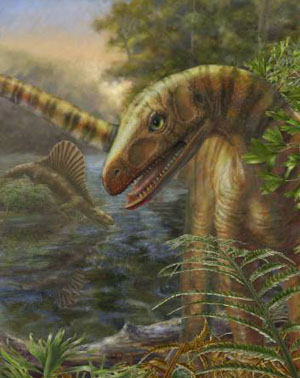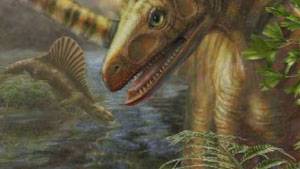Dinosaurs: are they 10 million years older?
Source: cosmosmagazine.com
Scientists have uncovered the bones of a dinosaur-like creature that roamed Earth at least 10 million years earlier than the oldest known dinosaur, according to a recent study.Discovered in Tanzania, Asilisaurus kongwe would have been waist-high to a human, ate plants, and lived some 240 million years ago, said the study, published in Nature.
The discovery means that dinosaurs probably appeared much earlier than previously thought, the researchers said.

An illustration of Asilisaurus kongwe.
Credit: Marlene Donnelly/Field Museum
Dinos just one of many large animal groups
It also points to a rich variety of fauna during the crucial period before dinosaurs began their 165-million domination of the planet.
"This new evidence suggests they were really only one of several large and distinct groups of animals that exploded in diversity in the Triassic, including silesaurs, pterosaurs [flying reptiles] and several groups of crocodilian relatives," said Sterling Nesbitt, a researcher at the University of Texas in Austin.
The newly found creature is a silesaur, which Nesbitt described as a "sister" taxon to the one that gave rise to dinosaurs.
Sister taxon in Tanzania
Their evolutionary relationship would be roughly analogous to that between humans and chimps, whose genomes overlap by 99%, he said.
Silesaurs and dinosaurs lived side-by-side throughout much of the Triassic Period, between 250 and 200 million years ago.
Fossil bones from at least 14 Asilisaurus specimens were recovered from a site in southern Tanzania. Scientists were able to reconstruct a nearly complete skeleton, with only small portions of the head and hand missing.
The animal stood half-a-meter to a meter (1.5 to 2.0 feet) tall at the hips, and were one-to-three meters (three-to-five feet) long.
Abundant life in Triassic
They weighed between 10 and 30kg, and walked on all four legs. The shape of the teeth and a beak-like lower jaw suggest that the animals could eat meat or plants. Scientists speculated that the animals were originally carnivores but evolved into omnivores to enhance their chances of survival.
While they did not persist as long as dinosaurs, silesaurs had a good run, lasting some 45 million years.
The first specimen from the silesaur group was discovered only in 2003, but since then eight other specimens have been dug up from Triassic rock around the globe. "This goes to show that there are whole groups of animals out there that we’ve never even found evidence of that were very abundant during the Triassic," Nesbitt said.
The names Asilisaurus kongwe comes from "asili," which means "founder" in Swahili, "sauros, the Greek for "lizard", and "kongwe," Swahili for "ancient."
Article from: CosmosMagazine.com






















